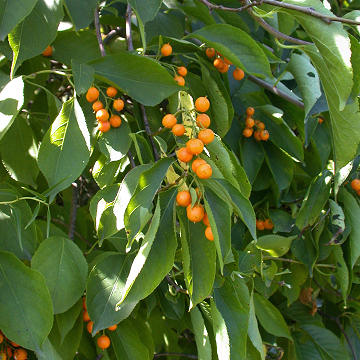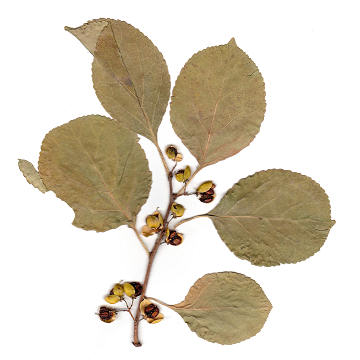

Celastrus scandens - (image 1 of 4)
Taxonomy
Family: Celastraceae (Staff-tree Family)
Habitat
Usually in rich soil, along road sides and in thickets.
Associates
Distribution
Quebec and Ontario west to Manitoba and WY, south to western SC, northern GA, eastern AL, LA, and TX.
Morphology
Twining woody vine to several meters. Leaves alternate, elliptic to oblong or ovate, serrulate, acuminate, 5-10 cm, mostly twice as long as wide. Dioecious or polygamo-dioecious. Flowers whitish or greenish, in terminal panicles 3-8 cm long; staminate flowers with 5 stamens about as long as the petals, inserted on the margin of the cup-shaped disk, pistil vestigial; pistillate flowers with a well-developed ovary, stout columnar style, and a 3-lobed stigmas, the stamens vestigial; ovules 2 per locule. Fruit orange, several in a cluster, to 1 cm, 3-valved, with each valve covering 1-2 seeds; seeds ellipsoid, 6 mm, completely enclosed in a fleshy red aril.
Notes
Flowers May and June
Wetland indicator: Upland
Oriental Bittersweet (C. orbiculatus Thunb.), native to eastern Asia, is similar and has escaped widely from cultivation; it has flowers 2-3 in short axillary cymes and with leaves that are typically broader than those of C. scandens. Oriental Bittersweet has become a serious problem in some of the dunes bordering southern Lake Michigan.

Celastrus orbiculatus
References
Gleason, Henry A.
and A. Cronquist. 1991. Manual of Vascular Plants of Northeastern United States
and Adjacent Canada. Second Ed.
The New York Botanical Garden. Bronx, NY
Swink, F. and G.
Wilhelm. 1994. Plants of the Chicago Region.
Indiana Academy of Science. The Morton Arboretum. Lisle, Illinois.
|
Michael Hough © 2004 |